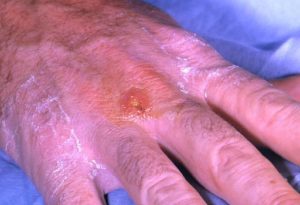Here at North American Game Company, we take the Health and Safety of both you, the customer, and ourselves, very seriously. We take all measures possible to ensure that our shop and equipment is kept clean and sanitary, as well as, free from anything chemically or biologically unhealthy.
We also want to make sure that you are keeping yourself safe and healthy while out hunting or around the farm. Here we have links to some common health concerns for hunters, ranchers, and for everyone in general.
Feel free to email or call us here at the shop about any questions or concerns you might have. Also check out these links to our most common health and safety concerns, our Shop Health and Safety page, and our Bushcraft page, which gives helpful tips on keeping yourself safe while bringing home the highest quality meats from the field. Below we have listed the three biggest health concerns that we have for hunters and the game that they may handle. Please practice proper health and safety, and sanitary game handling!
Chronic Wasting Disease

If you hunt deer, you’ve probably heard about CWD. This is America’s version of ‘Mad Cow’ disease. It is a prion disease which, in effect, melts the brains of the host animal. It is transmitted by the consumption of the brain or spinal fluids. To date, there is no conclusive scientific evidence that shows it can transmit to humans.
Chronic wasting disease (CWD) is a prion disease that affects North American cervids (hoofed ruminant mammals, with males characteristically having antlers). The known natural hosts of CWD are mule deer, white-tailed deer, elk, and moose. CWD was first identified as a fatal wasting syndrome in captive mule deer in Colorado in the late 1960s and in the wild in 1981. It was recognized as a spongiform encephalopathy in 1978. To date, no strong evidence of CWD transmission to humans has been reported. – CDC Website
Our policy here at North American Game Company is that all game meats that we process are always processed boneless. We always dispose of the bones and spine from animal and will not process these parts for food consumption, especially the skull, brain and spinal cord.
Rabbit Fever

This is Rabbit Fever and is traditionally spread by blood sucking bugs, such as ticks and deerflys. It can also be transmitted by open cuts or wounds on your hands when you skin the animal. Because of this, it is very important to be sure to wear gloves when handling wild rabbits, and washing your hands as soon as possible after handling. It is also very important to thoroughly cook your rabbit before consuming.
Tularemia is an illness caused by a bacteria, Francisella tularensis, which can affect both animals and humans. Most cases occur during the summer months when deerflies and ticks are abundant and the early winter months during rabbit hunting season. During hunting season, illness usually results from skinning infected rabbits. – Tularemia Fact Sheet
Most people can handle processing their own rabbits, however, we here at North American Game Company are more than happy to take care of your coney for you.
Swine brucellosis

This is an infectious disease that is popping up in wild pigs and boars in California, Texas, and the Southern States. It can be transmitted through contact with the animal’s blood or consuming improperly cooked meats. It is important that prior to hunting for wild swine, the hunter checks with their local Department of Wildlife to find out about conditions in your area of hunting and instances of infection. It is always advised to practice basic sanitation procedures when handling your game. Keep contact with the animal’s bodily fluids limited, and wash your hands as soon as is feasible. Also be sure to thoroughly cook any meat from wild swine to 165°F internal temperature.
Swine brucellosis is a zoonosis affecting pigs, caused by the bacteria Brucella suis. The disease typically causes chronic inflammatory lesions in the reproductive organs of susceptible animals or orchitis and may even affect joints and other organs.[1] The most common symptom is abortion in pregnant susceptible hosts at any stage of gestation.[2] Other manifestations are temporary or permanent sterility, lameness, posterior paralysis,spondylitis, and abscess formation. It is transmitted mainly by ingestion of infected tissues or fluids, semen during breeding, and suckling infected animals.[3] In humans, it can cause undulant fever.[4] – Wikipedia
See also the CDC’s page on their recent findings on Swine Brucellosis.